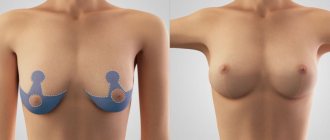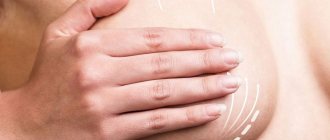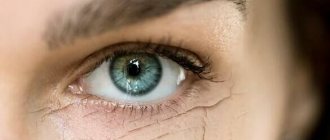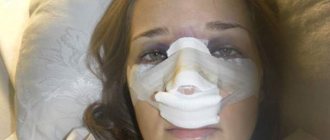Breast health » Breast surgery
- Probability of the situation occurring
Breast ripping is a rare type of post-operative complication that can occur in certain situations.
Let's analyze the characteristics of factors that can lead to the development of a defect, whether it poses a health hazard, disappears on its own, or whether it is necessary to take some measures to eliminate it, and in what specific ways it is removed.
What is ripping
Ripping after mammoplasty is nothing more than a type of postoperative complication in which the implanted implant becomes visually noticeable.
This clinical situation is known as “washboard waves” or “skin ripples” and most often is not fixed in nature, that is, it appears with a certain body position.
How to determine the presence of skin accordion:
- Characteristic folds appear when the body tilts forward.
- The flaw looks as if fingers ran across the chest and grooves appeared on its surface.
- Shrinking of the mammary glands is observed, which leads to the loss of their attractive appearance.
Doctors note that in women who have a sufficient amount of skin volume for normal coverage of prostheses, such an anomaly never forms or is practically invisible.
Where is it formed
If the implant is inserted under the pectoral muscle, waves will most likely appear at the edges of the chest, since there are no muscles there to cover the prosthesis.
As you lean forward, the ripples become more noticeable as they pull on the skin.
Ripping occurs more often with the introduction of saline implants, especially if there is little natural fatty tissue in the mammary glands.
This effect is explained by the chemical properties of the water-salt solution that fills the prosthesis.
When placing gel implants, ripping is rarely a concern, since the viscous gel holds its shape well.
If implants are too large, the bust may take on a rectangular shape instead of a beautiful smooth outline. And in the area where the muscles cannot cover the prosthesis, pronounced skin wrinkling will occur.
Read when you will have your first period after mammoplasty.
What should breast care be like after mammoplasty? Details here.
Types and types of condition
Can the problem go away on its own? There are two variations of ripping, so whether it disappears or not depends on its nature.
| Type of ripping | Key Features |
| Temporary | It is formed when the skin is stretched and insufficiently contracted after the disappearance of postoperative tissue swelling. It goes away in a short time on its own and forever. |
| Constant | It is invariably present, therefore, to eliminate it, repeated surgical correction is necessary. |
In addition, the likelihood of abnormal grooves on the skin in the bust area after plastic surgery is influenced by:
- The technique of the selected operation.
- Place of installation of the implant.
- Type and size of endoprosthesis.
- Initial breast size.
- The degree of elasticity and firmness of breast tissue.
Ripping has several forms of manifestation.
| Type | Nature of the complication |
| Waves | Wavy lines form across the entire area of the chest. |
| Partial ripples | An unpleasant defect in the form of corrugated areas can be observed throughout the entire mammary gland or in a specific area, but usually appears in the lower part. |
| Folds | Unevenness occurs only in certain body positions, usually when walking quickly or bending. |
| Modification of breast configuration | Some areas of the gland become strongly wrinkled, and the bust itself loses its smooth natural contours, taking on the shape of a pronounced rectangle or triangle. |
| Detected only upon palpation | Often, folds and dents appear only when the breast is felt. |
Possible negative consequences immediately after surgery
Seroma
Excess fluid in the cavity pocket, which leads to swelling, change in shape, leakage of fluid from the sutures, asymmetry, pain. If the problem is recognized immediately, it can be easily treated. Seroma appears due to genetic predisposition, intolerance to the implant material, physical activity, etc.
Hematoma
If a vessel is injured during surgery, blood will accumulate in the cavity pocket with the prosthesis. The hematoma will disappear on its own.
Keloid scars
Scars grow too much due to the individual characteristics of the body. It is impossible to predict such an outcome of events, so the situation is corrected with a dermastamp. Mini-punctures of the scar help the body to start the skin healing process in a new way.
Inflammation
The skin turns red, swelling appears, and severe pain occurs. The causes of inflammation are varied: a history of acute respiratory viral infection, movement of the implant inside the cavity due to the woman’s activity. In some cases, it is enough to take antibiotics; in some cases, the implant will have to be removed.
To minimize risks, first of all, you should follow the doctor’s instructions: wearing compression garments, rest, inactivity, taking prescribed medications, and timely examinations.
Causes of complications
Experts name a number of common reasons that can provoke ripples in the interbreast after mammoplasty:
- Small bust and lack of adipose tissue in women.
- Incorrectly chosen area for implantation of prostheses.
- Incorrectly selected type of implants.
- The use of dentures with a rough surface.
- Violation of mammoplasty technique.
Individual bust anatomy
The woman has a deficiency of breast skin, so its volume is not enough to completely cover the installed prosthesis.
The effect of corrugated paper is more often characteristic of thin women who have a deficiency of subcutaneous fat and, accordingly, a small bust. In this situation, when planning plastic surgery, the surgeon must take into account the physiological characteristics of the patient’s physique and explain to her the nature of possible postoperative complications.
Area of installation of prostheses
The location of the implant is also important. Preference is given to the option when the endoprosthesis is implanted in a submuscular manner (underarm). In this case, a thick layer of soft tissue in the axillary area allows you to effectively camouflage the prosthesis. In addition, the muscles have their own tone, which also reduces the likelihood of ripping.
When installing implants, the following nuances must be taken into account:
- Skin tissue can cover only half, or even two-thirds of the upper part of the prosthesis, so there will be some risk of wave formation in the lower fold of the bust.
- However, the axillary zone is an inconspicuous part of the body, so even with deep palpation you can feel the irregularities, but it is almost impossible to see them. Experts consider a slight manifestation of ripping near the armpits to be a completely acceptable situation.
- On the other hand, the central part of the chest muscles is well developed, but the closer to its outer borders, the more thin and flat they become. Therefore, when the prosthesis is placed under the muscle, the amount of tissue may not be enough for its outer edges. In this situation, there is a high probability of a fold forming on the side of the chest, but it will only be noticeable when tilted.
It is possible to completely avoid wavy unevenness only by installing a smaller implant than previously planned.
Implant model
Another common reason for the appearance of skin indentations is that when the endoprosthesis is placed in a vertical position, its upper half gradually shifts to the lower, so specific folds begin to form at the top of the chest. They appear clearly and expressed at the moment when, for some reason, there is a strong tension in the skin of the bust.
Typically, this phenomenon is typical for saline implants filled with a special saline solution:
- Such prostheses are characterized by increased mobility of their internal contents due to incomplete filling of their volume, which is due to the manufacturer’s instructions.
- The ripples are especially noticeable when the implant is installed above the pectoral muscle.
To reduce the occurrence of ripping, surgeons slightly increase the recommended volume of the internal material of the prostheses, which helps minimize the risk of complications. However, the risk of another problem increases:
- The implant acquires increased rigidity and is easily felt upon palpation.
- The risk of rupture and leakage of an overfilled denture increases.
As a result, surgeons recommend installing gel endoprostheses, which completely lack the above disadvantages.
Features of the surface texture of the endoprosthesis
Implants with a rough surface are more likely to cause a “washboard” effect than those with a perfectly smooth structure.
This situation is explained by the ability of breast tissue to “stick” to the rough surface of an installed foreign body. Complications can be avoided by installing the implant not over the pectoral muscle, but in a subpectoral manner.
Violation of the technique of performing the operation
Ripping appeared as a result of incorrectly performed plastic surgery. Usually, errors during an operation occur if it is not carried out by a sufficiently experienced specialist.
The occurrence of defective folds can be avoided even at the preparatory stage for surgical correction. It is necessary to discuss with your doctor the likelihood of their occurrence and try to exclude provoking factors:
- Entrust mammoplasty to an experienced and qualified surgeon who has many years of experience in this type of operation.
- Opt for those implant models that best suit your original bust volume. You should not choose prostheses of a significant size, dreaming of the largest possible breasts.
- Of all types of placement of prostheses, preference is given to the submuscular installation of endoprostheses, that is, under the breast muscle. This method significantly reduces the development of ripping.
- However, the danger of skin ripples is not completely excluded, since in any case the muscles can only cover half of the implant. Therefore, an accordion may appear in the lower area of the fold.
THE IMPLANT WILL BE VISIBLE TO OTHERS
— Will it be visible that the woman had mammoplasty?
- No. The installed implant feels and looks like a natural breast. No sharp outlines of the implant will be visible. Modern breast augmentation technologies allow women to acquire ideal breasts without any effort, which even a professional doctor cannot distinguish from the real ones. According to the patients themselves, the breasts look even more natural than before mammoplasty surgery. This can be judged from the photographs.
Who is at risk
Thin women of miniature stature who have small breasts and want to increase their bust from size zero to size four are at risk. It is these representatives of the fairer sex who have a lack of skin.
The installation of large implants in small breasts subsequently causes a postoperative complication in the form of skin ripples.
Such patients should listen to the advice of surgeons and maintain a sense of proportion when choosing endoprostheses of the appropriate size.
Probability of the situation occurring
Experts say that the occurrence of waviness depends on the size of the selected endoprostheses. The larger they are, the higher the risk of ripping.
However, this phenomenon refers to a rare type of complication that develops in certain situations, which were mentioned above.
In accordance with the statistics of the results of mammoplasty, the percentage manifestation of grooves depends on the structural features of the installed endoprostheses:
- Regular textured – 5-10%.
- Polyurethane - no more than 0.01%.
SCARS
— Women who decide to undergo mammoplasty are most often interested in where the postoperative scars will be located and how noticeable they will be.
— Don’t be afraid of scars - no matter how the implant is installed, they will be invisible in six months.
The location of the sutures largely depends on the method of mammoplasty that the plastic surgeon chose for his patient. When using modern breast augmentation techniques, incisions can be in the submammary area, around the areola - the pigmented area around the nipple, in the armpit, and less often - in the upper part of the navel. Incisions during mammoplasty are made carefully and delicately, so 6-12 months after surgery they become almost invisible. If the scars cause concern, they can be disguised using modern cosmetology means - resurfacing or tattooing.
How dangerous is the condition of “wavy breasts”?
In principle, the washboard effect is not considered a serious complication of mammoplasty. This phenomenon is completely harmless and rather acts as an aesthetic drawback, so it does not pose any serious danger to the patient’s body.
However, not all women want to have it, so surgeons try to minimize the likelihood of its formation, since in the future not all clients agree to have the operation repeated. Therefore, usually the ripping remains.
In addition, it is not always present, but appears only in a certain position of the body (body bending, active movement, etc.). The defect is often invisible to others, and only the woman knows about its presence.
BREAST TUMORS
— Perhaps most of all, women are afraid that breast enlargement will cause cancer.
“Nothing like this has been observed in all the many years of mammography practice. After careful research, it was found that the installation of an endoprosthesis does not provoke breast cancer. In addition, before mammoplasty surgery, any woman must undergo a mammogram to detect oncological processes, and after the operation such an examination must be completed every year. The need for an annual examination is a guarantee of optimal protection for women.
How long after plastic surgery do the first signs of ripping appear?
Ripple after mammoplasty can occur at different times after surgery:
- Immediately in the postoperative period.
- A little later with the subsidence of swelling.
- After a long time.
It usually appears when the swelling of the breast tissue completely subsides, and the skin remains stretched because it has not contracted enough due to its poor elasticity, so folds begin to form. In this case, the reason is not the implants - it is a temporary condition that completely disappears after the elasticity of the skin is restored.
Late ripping occurs due to other reasons (incorrectly selected size of prostheses, deficiency of adipose tissue, poor-quality implant, etc.).
Often, grooves can form against the background of sudden weight loss, so women with a slim figure should monitor their body weight and avoid rapid weight loss.
It is advisable for thin women to gain a little weight after mammoplasty, which will additionally give the breasts smooth natural lines by increasing the volume of subcutaneous fatty tissue, thereby reducing the risk of an unpleasant defect.
In what cases do negative consequences occur after mammoplasty?
- Incorrectly selected implants.
- Medical errors during surgery and at the preparation stage.
- Individual characteristics of the body.
Endoprostheses are selected based on more than 30 parameters. In this article, we will only consider errors related to size and shape. The doctor must predict how the shape of the breast will change over time and during lactation. If endoprostheses are too large, the contours of the implant will be visible through the skin, and breast ptosis (drooping) is possible. Too small ones will not solve the problem of sagging, as they will not occupy the entire internal cavity.
Ways to eliminate ripping
If ripples appear after mammoplasty, how to correct them? Unfortunately, this phenomenon can only be eliminated by repeated surgery.
Previously, the “accordion” effect was eliminated by replacing saline prostheses with gel ones or by moving them to the muscle of the inframammary region. Modern plastic surgery offers other options to effectively deal with the problem:
| Remedies | Features of corrective mammoplasty |
| Lipofilling | A woman's fat tissue is transplanted from one area of the body where there is excess fat to the breast area. Fat transplantation allows you to give the bust additional volume, thereby making the existing ripping almost invisible. |
| Replacing existing dentures with a smaller size | It is performed in case of installation of very large primary implants. However, if the patient does not want to correct the defect by reducing the volume of the bust, she will have to come to terms with the presence of grooves. |
| Complete removal of dentures | It is performed at the request of a woman who has changed her mind about having a full bust and wants to get rid of all the complications that arose from mammoplasty, or there are other clinical indications for the removal of prostheses. |
| Replacing implants with others with a high degree of density | A similar correction is made in situations where ripping is caused by insufficient internal fluid in already implanted prostheses. |
| Establishment of dermal collagen matrix | Allows you to disguise skin unevenness. It is practiced when the skin is extremely thin. |
REPEATED OPERATION
— It is believed that the implant has a certain shelf life. When it expires, the silicone needs to be replaced. So, will you have to go under the plastic surgeon's knife again?
- This is wrong. Modern companies that manufacture implants provide a lifetime guarantee on their products, so that once a woman has enlarged her breasts using mammoplasty surgery, she will enjoy its elasticity and perfection for the rest of her life. Repeated surgery is required only in exceptional cases, with suppuration and inflammation, but this happens very rarely. The feasibility of changing the implant and repeat mammoplasty is assessed by the doctor.
IMPOSSIBILITY TO BREASTFEED A CHILD
— Should women be afraid that after mammoplasty they will not be able to breastfeed their child?
— Installation of the implant does not affect the milk ducts, so the operation does not affect the feeding of the child. Numerous studies have shown that silicone molecules do not penetrate into breast milk, since they are securely hidden in the thick shell of the implant. Another thing is that after pregnancy, childbirth and breastfeeding, the breasts may sag - then a second operation may be required.
I hope I was able to prove to readers that mammoplasty is a modern and aesthetic way to get beautiful breasts without much effort. Such breasts look natural and do not lose their sensitivity and attractiveness. See for yourself!
How to replace breast implants
The duration of surgery to install new implants is about two hours, in complex cases it lasts up to four hours. The correction is carried out under general anesthesia and the supervision of an anesthesiologist.
Preparing for surgery
Preparation begins with a consultation. The implant surgeon conducts a survey and examination. Asks about allergic reactions to drugs, chronic diseases, bad habits. Prescribes consultations with other medical specialists: endocrinologist, immunologist, mammologist, oncologist.
The surgeon determines the scope of research. In addition to standard tests, additional tests, such as mammography, may be prescribed. The implantologist develops a plan for the operation, which may include not only prosthetics, but also other types of correction.
One and a half months before mammoplasty, the patient must give up alcohol and smoking. During the week before surgery, you should not take medications, blood thinners, or anti-inflammatory drugs.
Features of the operation
The operation is performed in several stages, the volume of intervention depends on the specific situation:
- The incision is made along the contour of the previous mammoplasty scar.
- Old implants are removed along with the fibrous membrane.
- A new prosthesis is installed in the same implantation pocket.
- Stitches and bandages are applied.
Possible complications
Complications after repeat arthroplasty are rare:
- Inflammation
occurs for two reasons: due to tissue infection during surgery or as a result of the patient’s physical activity in the postoperative period. At this time, the endoprosthesis is not yet encapsulated, that is, it is not covered with a fibrous membrane, so it rubs the surrounding tissues. The chest can become inflamed due to a viral infection, such as ARVI. The problem is indicated by pain, swelling, and increased temperature. The inflammatory process can progress to gray and then cause capsular contracture. - Seroma
is a collection of serous fluid between the implant and tissues. This formation causes swelling of the soft tissues, pain, and changes in the shape of the gland. Serous fluid may ooze from the wound. With seroma, the pocket stretches, the breast is deformed, and asymmetry of the glands occurs. The reasons may be the body’s reaction to the endoprosthesis, hypertension, refusal of compression garments and physical activity during the recovery period. Small seromas resolve immediately; large seromas need to be drained. - Hematoma
is an accumulation of blood in the prosthesis pocket. Small ones resolve within two weeks, large ones can fester. In this case, the doctor prescribes treatment depending on the situation (antibiotics, drainage or opening of the implantation pocket). - Loss of sensitivity
- associated with the intersection of axons (processes) of small nerves during surgery. Sensitivity is usually restored after a few months. Physiotherapeutic procedures and a complex of vitamins can speed up the process.
Today, there are 2 methods of breast enlargement: installation of silicone implants and injection of your own adipose tissue - lipofilling. And a lot of debate about which one is better.
But, as the famous American plastic surgeon Thomas Biggs said, “there is no one key that opens all doors.” In other words, each category of patients has its own operation: both have pros and cons.
Installation of silicone implants
allows you to enlarge your breasts by 2-3 sizes and radically change their shape. It is performed through 3 main approaches: transaxillary (axillary), submammary (inframammary) and periareolar (along the upper or lower edge of the areola). As for morbidity, when performing a periareolar approach, the incision passes through the gland tissue. And in the presence of asymmetry, tubularity, the need to lower the submammary fold (which occurs quite often), in order to create a beautiful shape, it is also necessary to destroy the structure of the gland.
Immediately after the operation, the implant is held in the correct position only by the elasticity of the soft tissues injured by the intervention. Only after 2-3 months the inflammatory phenomena around it will subside and a connective tissue membrane will form, which will separate the implant from the body tissues. Whether it fixes it to the surrounding tissues and whether it will hold it in one place or not depends on the type of implant. For reference: all modern implants are divided into 2 types, and only implants with polyurethane foam coating are fixed; all others are not fixed. In any case, it is very important to wear compression garments and follow the recommendations of the operating surgeon.
Lipofilling
– breast enlargement using your own fat tissue. In 1 session, depending on the volume of injected fat, you can increase the volume by 1, maximum 1.5 sizes. Lipofilling can expand the mammary gland spot, fill the upper slope, narrow the interbreast distance, but it cannot radically change the shape. She will remain natural.
The exception is the tubular mammary gland, when in combination with a periareolar lift we create an even, round, slightly flattened, natural drop.
During the operation, fat is injected above and below the gland, i.e. the mammary gland is not affected. To perform breast lipofilling, a sufficient number of donor areas is required.
It makes no sense to deny the fact that after breast augmentation you can get a complication - it is possible after any surgical intervention. There are potential risks of surgery and side effects. The first may not occur, but the second will certainly pass, but for everyone at different speeds, depending on the individual characteristics of the body.
Whether a complication occurs or not depends on many factors: the surgical technique, the characteristics of the patient’s anatomy and physiology, types of implants, previous operations, the body’s reaction to lipofilling or a foreign body (implant). And, of course, from the competent behavior of patients after surgery and strict adherence to all recommendations.
But if complications were common, then plastic surgery would be prohibited.
NB: The examples illustrating the complications in this article were collected not only by us, although for many years we have performed alterations (re-endoprosthetics) of other people’s work more often than primary operations. Many of the clinical cases that will be described below are not considered by the owners themselves to be a complication and are absolutely satisfied with the result.
What are the side effects after breast augmentation?
This is the name for regular phenomena/symptoms that are always observed in the operated area. Their appearance is associated with tissue trauma and is temporary.
Side effects necessarily disappear during the rehabilitation process, but the duration of the recovery period is individual and depends on the anatomical and physiological characteristics of the body. In other words, the body reacts to any injury with inflammation - even in the absence of infection (this inflammation is called aseptic).
side effects
appear The inflammatory process is a mechanism inherent in nature to restore tissue after any damage. Local side effects/inflammation are expressed by the following symptoms, which we always observe after any breast surgery:
1. Edema
appears from the end of the first day after surgery and slowly increases up to 3-5 days, reaching a maximum. Then it stays at the same level for 2-4 days and begins to gradually decrease. Swelling may wax and wane asymmetrically. The greater the volume of glandular tissue, the longer the swelling persists. The main swelling goes away by 3-4 weeks after the operation, but will periodically return - “walk” - increasing in the second phase of the cycle, after consuming alcohol, salty, sweet or spicy foods, with increased physical activity, etc. Therefore, the final result follows assess no earlier than 3-4 months after surgery.
2. Consequence of vascular damage
– hematomas, bruises and bruises that appear both immediately after surgery and within several days, gradually appearing against the background of decreasing swelling. Bruises “fade” and resolve within 10-20 days. The larger the area of hematomas, the longer they will take to heal.
The peculiarity of lipofilling is that there will be swelling and bruising both in the chest area and in the area of the donor areas treated with liposuction. In donor areas, as a rule, longer.
3. Redness
in the first days it can be observed in the form of individual spots, “marbling” or around the seams. Goes away on its own within 2-3 days. The appearance of intense redness at a later date indicates infection and requires separate treatment.
4. Discomfort
varying degrees of severity. The degree of pain depends on your personal pain threshold. The pain is more severe after endoprosthetics, accompanied by detachment of the pectoralis major muscle. Such manifestations last 3-7 days and are easily relieved with simple painkillers. Pain in the breast area is not typical for lipofilling. More likely, pain will be observed in the donor areas if they are located in the ribs, lower back, front and inner thighs.
5. Sensory impairment
– its increase or decrease. The soft tissues of the breast are penetrated by many nerve endings, especially in the immediate vicinity of the nipple. During the installation of the implant, nerve endings may be injured or compressed by swelling in the postoperative period. Sensitivity is restored within 3-6 months after surgery.
When performing lipofilling, there is no loss of sensitivity in the breast area. A feeling of numbness may occur after liposuction, for example on the front of the thighs.
6. Formation of a postoperative scar
at the incision site. After endoprosthetics, a permanent (can be very thin) scar remains in the armpit (usually hardly noticeable), around the areola or under the breast. The length of the incision is usually 4-5 cm; when performing a lift, it can be longer.
After lipofilling there are no marks left on the breast. On the body, in the area of donor zones, scars are 3-4 mm long.
If you cut your finger with an awkward movement, the wound (even a small one) will heal in 7-14 days. The deeper and larger the wound, the longer. It will definitely become inflamed: first it will turn red, swell, there may be discharge or bruising, and it will definitely hurt. Then it will gradually clear and heal, but a scar will remain in the center - a section of connective tissue that appears if the epidermis does not have time to “collapse”. Possibility of marginal epithelization (i.e. restoration of the surface layer of the skin) 5 mm. Damage that is larger in area is sure to scar.
The scar will initially be bright red and dense, with impaired sensitivity. Gradually it turns pale, decreases in size and becomes soft. But if you sunbathe while the scar is bright red, it will become pigmented for a long time. The pigment may gradually lighten over 1-3 years, or may remain for life. This is a normal course of the recovery process - wound healing. But in cases where there is an imbalance in the body, the function of the connective tissue and immune system is impaired, their activity is increased, and hypertrophic and keloid scars appear.
What are complications
after breast augmentation
Complications after mammoplasty are pathological processes that occur in the postoperative period and are a consequence of the surgery, an atypical reaction of the body to a foreign body (implant) or the introduction of fatty tissue into the breast area. For lipofilling, complications are added that can arise in the area of donor areas due to liposuction. Complications do not always develop; their occurrence is not at all necessary.
Complications often occur due to:
— pathological reactivity of the body (those individual characteristics of anatomy and physiology);
- hormonal disbalance;
- reaction to an implant, which is a foreign body for the body;
- previous operations;
— violation by the patient of the prescribed diet, physical activity regimen, and rules for taking medications;
— violation of the terms of wearing compression garments.
Timing of complications after breast augmentation
According to the timing of occurrence, complications after breast augmentation are usually divided into:
1. Early complications after breast augmentation develop during the first hours and up to 5-7 days after surgery.
2. Late complications may appear 7 days or more after surgery.
Types of complications after breast augmentation with silicone implants
Hematoma
- accumulation of blood in the tissues around the implant. Appears as a result of bleeding from a damaged vessel. In the early postoperative period, a hematoma can occur with a sharp rise in blood pressure, a blood clotting disorder, or diabetes mellitus. To prevent the formation of hematoma, active drains are installed in the implant bed, which will remove fluid 1–3 days after breast augmentation.
In the late postoperative period, a hematoma may appear as a result of the patient’s early refusal to wear compression garments, excessive physical exertion, non-compliance with the regimen, increased physical activity, sexual contact in the first days after surgery; as a result, displacement of the prosthesis and disruption of the integrity of blood vessels may occur. The hematoma is eliminated using puncture and aspiration, and in some cases a repeat operation and removal of clots is necessary: revision of the postoperative wound.
Seroma
– accumulation of tissue fluid in the cavity or around the implants. It occurs due to the reaction of breast tissue to the implant - accumulation of fluid or dissolution of a large hematoma. Early seromas occur in the first 2 weeks after surgery. Late seromas may appear 1-6 months after surgery for no apparent reason. Gray must be removed by drainage and aspiration, as it can become infected or cause rotation/displacement of the implant.
Rotation of the implant
is more important for anatomically shaped implants, however, a round implant can also rotate its base anteriorly. It may be caused by the accumulation of a hematoma or seroma around the implant or a violation of the postoperative regimen. Leads to deterioration of the breast shape and requires repeated surgery with replacement of implants, but not earlier than 3-6 months after the first. Rotation can be habitual and repeated. Patients get used to it and deftly put the implant in place.
Thrombophlebitis of the superficial veins of the anterolateral surface of the chest and abdominal walls and the area of the mammary glands
called Mondor's syndrome (named after the French surgeon who described this disease in 1939). Most often occurs when installing implants using submammary access.
This disease is described infrequently, but not because of its rarity, but primarily because of its gradual course and self-healing. With Mondor's disease, patients develop painful, cord-like thickenings along the vessels on the chest and abdominal wall in the area of the mammary gland, sometimes up to 20 cm in length. In this case, the body temperature may rise to subfebrile. During this period, a blood clot can be found in the veins, the vein is dilated, and its walls are thickened.
In the second phase of the disease, which occurs 10-14 days after the onset, the vein undergoes sclerosis. The skin, due to its proximity to the vein and the absence of fascial layers between them, is involved in the inflammatory process. Therefore, when the skin is stretched, especially when raising/abducting the arm, radial wrinkles appear along the veins.
Symptoms may appear 1-3 weeks after surgery.
The prognosis for recovery is good. Treatment: taking anti-inflammatory drugs, semi-alcoholic wet-dry compresses, applying heparin-containing creams. Infection of a postoperative wound
is a rather rare complication, the signs of which are increased body temperature, increased redness, pain, increased swelling of soft tissues, increased body temperature, etc. For prevention, antibiotics are administered during surgery.
Allergic reactions
on silicone implants are extremely rare.
Rough postoperative scar.
Some patients with a tendency toward tissue hypertrophy (thickening) may develop hypertrophic or keloid scars, which require additional treatment. They are rough, thick, noticeable scars that rise above the surface of the skin, remain red for a long time, are itchy, and, if a keloid is present, grow throughout life. The likelihood of their occurrence directly depends on the characteristics of the patient’s body. Improper wound healing is a genetic predisposition, therefore, to prevent severe scarring during wound healing, drying antiseptics, pressure bandages, compression, healing agents, and silicone-containing preparations (Dermatix, Kelo-Kot, Mepiform) are used.
The formation of a “bad”, wide scar is caused by strong tissue tension and intolerance to the suture material. In the second case, 2-3 weeks after the operation, local redness and suppuration will appear in the suture area, which will open on its own. If a piece of thread or a knot comes out, the wound heals on its own. If not, it becomes crusty and periodically festeres. It is necessary to remove the thread, otherwise a fistula may form. The body will not calm down until it pushes out the foreign material. At the site where inflammatory elements appear, the seam will be wider.
Animation deformations
occur when the pectoralis major muscle is strained when implants are installed under the muscle.
Asymmetry
– installed implants behave differently. One remains in place or moves outward, upward, and the second downward.
Fibrous or capsular contracture.
A silicone implant is a foreign body, so the body, by fencing itself off, protects itself from it by forming a dense shell of connective tissue around the prosthesis. This shell is called a fibrous capsule and it is always formed (!) after the installation of implants. In some patients it remains thin and soft throughout their lives, while in others it can become very dense and put pressure on the implant. As a result, discomfort and sometimes painful sensations appear, the breast becomes hard, its shape is deformed, waviness and contouring of the prosthesis appears.
IT IS IMPOSSIBLE TO PREDICT WHETHER A CAPSULARY CONTRACTURE WILL OCCUR AND WHAT IT WILL BE BEFORE THE OPERATION!
There is a generally accepted classification of the degree of Baker's capsular contracture, depending on the severity of its symptoms:
I degree. The breasts are soft and have the same density as before the operation - this is the norm.
II degree - you can feel the edges of the implant, the mammary gland is denser than before surgery.
Stage III is characterized by pronounced breast compaction. You can not only feel the very dense implant, but also see its contours.
IV degree - upon palpation (feeling), the mammary gland is deformed, inelastic, painful and very hard.
The presence of fibrous contracture of grades III and IV requires surgical intervention: the capsule must be completely removed and the implant replaced, preferably with a polyurethane-coated implant.
There are several reasons that contribute to the occurrence of capsular contracture:
1. Operation. The accumulation of blood in the tissues around the implant is a hematoma. Rough operating technique and insufficient hemostasis (stopping bleeding). Infection of tissues as a result of infection from the outside or due to the presence of chronic inflammatory processes. Damage to the mammary ducts.
2. Implant. The discrepancy between its size and the size of the pocket formed for it. Insufficient inertness of the material from which the prosthesis is made. The type of filler and its ability to sweat through the implant shell. Place of installation and type of incision - placed through an incision under the mammary gland and installed under the pectoral muscle are less likely to lead to contracture.
3. Individual characteristics of the organism. Foreign body reaction and genetic predisposition to gross scarring.
4. External reasons. Exposure to chronic intoxication (nicotine or certain chronically used medications). Micro- or macrotrauma of the mammary glands. Significant physical activity contributes to the formation of a hematoma or seroma around the prosthesis.
"Waviness" or ripping or rippling, and contouring of the edges of the implant
represents the appearance of waves and visualization of the edges of the implant. Waves and contouring may be visible when the chest is in a relaxed position, as well as when bending over or walking. This complication usually occurs in thin patients with a small amount of covering tissue and an undeveloped mammary gland when installing an implant with a soft gel, especially quickly if the implant has a smooth shell.
The waviness can be eliminated only by repeated surgery with the installation of an anatomically shaped implant filled with a denser gel or with a polyurethane coating, as well as lipofilling.
Implant shell rupture
– an extremely rare complication that can be associated with chest trauma or long-term capsular contracture, which, by squeezing the implant, creates creases and conditions for chafing of the membrane.
"Double bubble"
(“double-bubble”) occurs on the lower slope of the mammary gland. After its increase, a transverse stripe appears - a trace from the old submammary groove, which remains after its understatement. Especially often with tubular breasts, due to underdevelopment of the lower slope of the mammary gland. In such cases, it is dense, inextensible (otherwise called constrictive). Eliminated by repeated surgery or lipofilling in combination with rigototomy.
Secondary breast ptosis
. It is customary to distinguish between primary and secondary breast ptosis. Primary occurs due to natural causes, and secondary after breast augmentation with implants. The mammary gland, as a suspended part of the body, is subject to gravity (gravity), as well as hormonal changes. The so-called secondary ptosis is one of the most common complications of surgery, requiring surgical correction.
"Ball in a Sock"
(“ball in sock”) – rapid progression of secondary breast ptosis (sagging). Often secondary ptosis occurs when an implant is installed under the mammary gland, especially in the presence of initial ptosis before surgery. In this case, the volume and weight of the breast increase, which leads to rapid sagging of the breast along with the prosthesis. Correction requires a repeat operation: reinstallation of the implant under the pectoralis major muscle and breast lift using a prosthesis.
"Tomato"
(“tomato breast”) – breast deformation after periareolar lift with endoprosthetics. It is a flattening of the cone of the mammary gland, resembling a tomato in appearance.
Sliding of the implant down the chest wall
(“bottoming out”) is called prosthetic ptosis. If, during installation of the prosthesis, the submammary groove was destroyed and not secured, then the prosthesis can slide, sink below it, fall out, and the mammary gland will remain in its original state.
Synmastia or breast fusion
(“sinmastiya”). This complication after breast augmentation occurs due to the installation of very large implants or the surgeon’s desire to excessively narrow the interthoracic distance. In any case, synmastia requires repeated surgical intervention, narrowing of the implant bed and installation of a smaller prosthesis.
"Waterfall"
(“snoopy” (free translation from English - an animal that sticks its nose everywhere), or “waterfall deformity”) - sliding of breast tissue from a stationary implant. As a rule, such a complication develops when the initial significant stretching and/or large volume of breast tissue occurs when an implant is installed under the pectoralis major muscle. Requires repeated surgery, displacement of the implant to a lower position, with a possible increase in its volume and breast lift/resection of gland tissue on the implant.
Types of complications after breast augmentation with lipofilling
Contraindications to breast lipofilling:
multiple large cysts (more than 10 mm in diameter), neoplasms, heredity of breast cancer, lack of sufficient donor areas.
Aseptic inflammation
usually manifests itself in 1-3 days and can be easily removed by local application of hormonal ointments.
Discomfort
varying degrees of severity are observed quite rarely, rather a feeling of swelling or distension. The degree of discomfort depends on the individual pain threshold, lasts 3-7 days and is easily eliminated with painkillers.
When performing lipofilling of significant volumes of seroma
may occur in the liposuction area, such as the sacrum or abdomen. To prevent them, drainage is often installed for 1-5 days after surgery.
Irregularities, compactions
Sometimes you can feel in areas of transplanted fat. Seals appear as a result of aseptic inflammation around the “droplets” of transplanted fatty tissue and active, but uneven blood flow. Impaired fluid outflow due to temporary lymphostasis disrupts the nutrition of the transplanted fat and prevents it from taking root. Irregularities and lumps that are detected during the first 3 weeks after surgery are not dangerous and nothing needs to be done about them, but it is important to monitor them. You cannot massage them, much less press them, otherwise a “pit” will appear in place of the “lump”. Most of the irregularities and indurations go away on their own, as the swelling and vascularization (sprouting with blood vessels) of the transplanted fatty tissue disappear.
If irregularities and compactions persist for more than three weeks, you must definitely contact your surgeon, as they can develop into complications - persistent irregularities and compactions due to the formation of scar tissue in the place of lost fat. Most likely, the surgeon will prescribe a gentle finger massage 3-4 times a day and/or a course of physiotherapeutic procedures, which should lead to their disappearance. It is possible to perform a puncture. With physical therapy, unevenness and compaction go away faster.
Large drops of fat in some cases form cysts
. Most often they go away on their own within 3-9 months after surgery. This process can be accelerated with the help of physiotherapy (microcurrents, ultrasound) and homeopathy.
In some cases, in the postoperative period after breast lipofilling, cysts may appear in the mammary gland due to hormonal imbalance. An experienced ultrasound specialist can easily determine whether a glandular cyst is a fatty one. In this case, you need to contact a gynecologist who will select the necessary therapy.
Calcifications
– fat drops of large diameter can be separated from the surrounding tissues by scar tissue with the formation of cysts, the walls of which can calcify over time, that is, thicken due to the deposition of calcium in them.
*It is for this reason that breast lipofilling was prohibited for a long time.
In 1987, the American Society of Plastic and Reconstructive Surgeons decided to ban breast fat grafting. The reason for the taboo is the difficulty of differential diagnosis between microcalcifications after lipofilling and breast cancer.
Despite the ASPRS ban, European and Asian doctors continued to use the method for the purpose of breast augmentation and reconstruction, reducing the degree of capsular contracture, and correcting the contours of implants after endoprosthetics. From France, Italy, China, Japan and even from the USA, there have been reports of breast lipofilling with consistent positive long-term results. Even later, in 2001, P. Zuk and M. Zhu discovered that adipose tissue contains stem cells. Leading plastic surgeons and clinics from different countries conducted scientific research and practical experiments, trying to solve the problem of fat cell survival and improve the breast lipofilling technique.
The course of history was changed by the famous American surgeon R. Khouri, who in 2006 reported on a long-term study of breast lipofilling. With consistent positive results, he used lipofilling to enlarge and reconstruct mammary glands after their removal for cancer. By that time, there were more than 10,000 results. At this point, diagnostic methods had become so advanced that it was not difficult for an experienced specialist to distinguish calcification, which arose as a result of lipofilling, from an oncological disease.
In the same 2006, ASPRS lifted the taboo on lipofilling for the purpose of breast reconstruction, and in 2007 it gave the green light to the use of one’s own fat to enlarge the mammary glands. The lock was removed, but the sediment remained...
Panniculitis
– a complication that is actively discussed in all topics of lipofilling – inflammation of the skin and subcutaneous fat. THERE ARE NO BREASTS AFTER LIPOPILLING. IT OCCURS (QUITE RARELY!) AFTER LIPOPILLING OF THE SHINS.
There is always a reason for this complication to occur! Occurs 4-8 weeks after surgery. Most often after an infectious disease or exacerbation of chronic, long-term lymphostasis in the presence of venous insufficiency, as well as depilation, visiting a bathhouse. Bright, hot spots appear, rising above the surface of the skin, swelling, itching, burning and distension intensify. It may leave behind temporary pigmentation. A course of physiotherapeutic procedures (microcurrents, magnets, polarized light) in combination with antibacterial and hormonal therapy, wearing compression underwear helps.
Summing up
: if you compare the consequences of two operations - endoprosthetics and breast lipofilling - then lipofilling wins. BUT! Not in all cases lipofilling can be performed: thin patients who need augmentation (even small!) do not have a sufficient amount of adipose tissue; in the presence of 2-3 degree ptosis (especially glandular!), even in combination with a lift, it is advisable not to perform lipofilling, since the transplanted fat will make the tissue heavier and will contribute to the progression of their ptosis.
And we must not forget that with an initial bra cup size of 0, several sessions must be performed to achieve a significant increase. Therefore, breast replacement will remain relevant for many women. Let us repeat once again: each operation has its own indication and contraindication, as well as an “ideal patient”. And optimism, in our opinion, is inspired by the fact that the professionalism of plastic surgeons is growing, education has become more accessible (if only there was a desire!), breast augmentation techniques are being honed, equipment is improving, awareness and prudence are growing among patients, and manufacturers of silicone implants are fighting for the market Every year they improve their quality and range, using the most modern achievements and developments.
Breast augmentation is considered the most “beautiful” operation in plastic surgery, and its popularity is only increasing every year. The unbridled pursuit of an attractive bust has generated an impressive number of offers promising magnificent breasts in exchange for the purchase of creams, pills, meditation techniques and even electronic equipment. However, the reality is that today the only effective method is plastic surgery.
And most often, breast augmentation operations are successful. The main thing is to remember that this is an operation, prepare for it, be careful when choosing a surgeon (you don’t need to choose only based on cost), be patient, understand the importance of the rehabilitation period, be aware of the risks and be sure to follow all the doctor’s orders.
To communicate with patients who have undergone breast augmentation, lifting or reduction, come to our forum in the Mammoplasty











